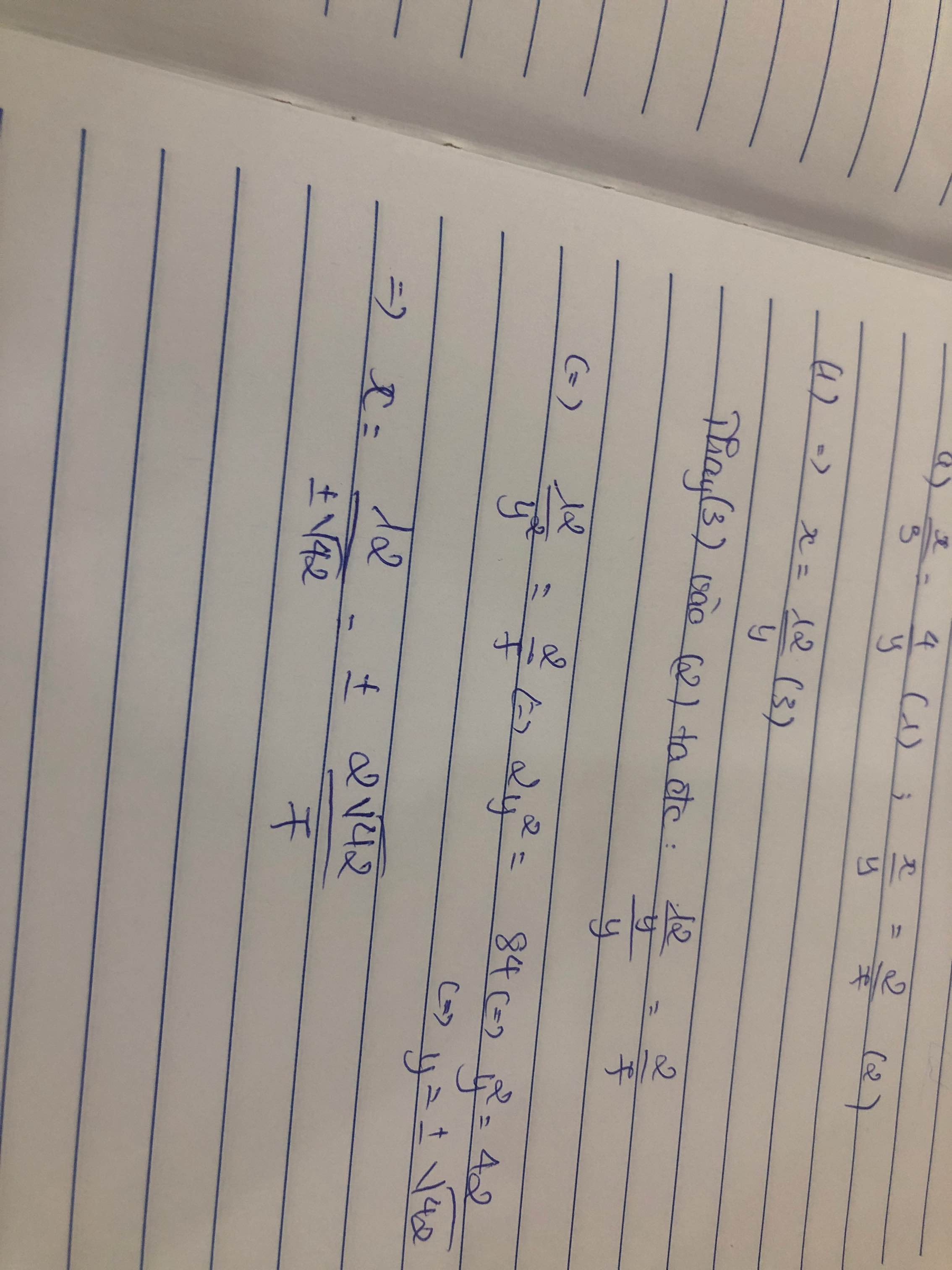Hãy nhập câu hỏi của bạn vào đây, nếu là tài khoản VIP, bạn sẽ được ưu tiên trả lời.

Lời giải:
Ta có: \(\frac{y^2-x^2}{3}=\frac{y^2+x^2}{5}\Rightarrow 5(y^2-x^2)=3(y^2+x^2)\)
\(\Rightarrow 2y^2=8x^2\Rightarrow y^2=4x^2\)
\(\Rightarrow y^{10}=4^5x^{10}=(2x)^{10}\)
Do đó:
\(x^{10}y^{10}=x^{10}.(2x)^{10}=1024\)
\(\Leftrightarrow (2x^2)^{10}=1024=2^{10}=(-2)^{10}\)
\(\Rightarrow \left[\begin{matrix} 2x^2=2\\ 2x^2=-2(\text{vô lý})\end{matrix}\right.\)
\(\Rightarrow x^2=1\Rightarrow x=\pm 1\)
\(y^2=4x^2=4\Rightarrow y=\pm 2\)
Vậy \((x,y)=(1,-2); (1,2); (-1,2); (-1,-2)\)

\(a.\)
\(\dfrac{x}{2}=\dfrac{y}{5}\)
Áp dụng tính chất dãy tỉ số bằng nhau :
\(\dfrac{x}{2}=\dfrac{y}{5}=\dfrac{x+y}{2+5}=\dfrac{35}{7}=5\)
\(\Rightarrow x=5\cdot2=10\\ y=5\cdot5=25\)
\(b.\)
\(\dfrac{x+2}{y+10}=\dfrac{1}{5}\)
\(\Leftrightarrow\dfrac{x+2}{1}=\dfrac{y+10}{5}\)
\(\Leftrightarrow\dfrac{3x+6}{3}=\dfrac{y+10}{5}\)
Áp dụng tính chất dãy tỉ số bằng nhau :
\(\Leftrightarrow\dfrac{3x+6}{3}=\dfrac{y+10}{5}=\dfrac{y+10-3x-6}{5-3}=\dfrac{2-4}{2}=-1\)
\(\Leftrightarrow\left\{{}\begin{matrix}3x+6=-3\\y+10=-5\end{matrix}\right.\)
\(\Leftrightarrow\left\{{}\begin{matrix}x=-3\\y=-15\end{matrix}\right.\)
\(c.\)
\(\dfrac{x}{4}=\dfrac{y}{5}\)
\(\Leftrightarrow\dfrac{2x}{8}=\dfrac{y}{5}\)
Áp dụng tính chất dãy tỉ số bằng nhau :
\(\dfrac{2x}{8}=\dfrac{y}{5}=\dfrac{2x-y}{8-5}=\dfrac{15}{3}=5\)
\(\Leftrightarrow\left\{{}\begin{matrix}2x=5\cdot8\\y=5\cdot5\end{matrix}\right.\)
\(\Leftrightarrow\left\{{}\begin{matrix}x=20\\y=25\end{matrix}\right.\)
a) Ta có: \(\dfrac{x}{2}=\dfrac{y}{5}\)
mà x+y=35
nên Áp dụng tính chất của dãy tỉ số bằng nhau, ta được:
\(\dfrac{x}{2}=\dfrac{y}{5}=\dfrac{x+y}{2+5}=\dfrac{35}{7}=5\)
Do đó:
\(\left\{{}\begin{matrix}\dfrac{x}{2}=5\\\dfrac{y}{5}=5\end{matrix}\right.\Leftrightarrow\left\{{}\begin{matrix}x=10\\y=25\end{matrix}\right.\)
Vậy: (x,y)=(10;25)
b) Ta có: \(\dfrac{x+2}{y+10}=\dfrac{1}{5}\)
nên \(\dfrac{x+2}{1}=\dfrac{y+10}{5}\)
hay \(\dfrac{3x+6}{3}=\dfrac{y+10}{5}\)
mà y-3x=2
nên Áp dụng tính chất của dãy tỉ số bằng nhau, ta được:
\(\dfrac{3x+6}{3}=\dfrac{y+10}{5}=\dfrac{y-3x+10-6}{5-3}=\dfrac{2+4}{2}=3\)
Do đó:
\(\left\{{}\begin{matrix}\dfrac{3x+6}{3}=3\\\dfrac{y+10}{5}=3\end{matrix}\right.\Leftrightarrow\left\{{}\begin{matrix}3x+6=9\\y+10=15\end{matrix}\right.\Leftrightarrow\left\{{}\begin{matrix}3x=3\\y=5\end{matrix}\right.\Leftrightarrow\left\{{}\begin{matrix}x=1\\y=5\end{matrix}\right.\)
Vậy: (x,y)=(1;5)
c) Ta có: \(\dfrac{x}{4}=\dfrac{y}{5}\)
nên \(\dfrac{2x}{8}=\dfrac{y}{5}\)
mà 2x-y=15
nên Áp dụng tính chất của dãy tỉ số bằng nhau, ta được:
\(\dfrac{2x}{8}=\dfrac{y}{5}=\dfrac{2x-y}{8-5}=\dfrac{15}{3}=5\)
Do đó:
\(\left\{{}\begin{matrix}\dfrac{x}{4}=5\\\dfrac{y}{5}=5\end{matrix}\right.\Leftrightarrow\left\{{}\begin{matrix}x=20\\y=25\end{matrix}\right.\)
Vậy: (x,y)=(20;25)

a, \(\dfrac{x}{2}=-\dfrac{5}{y}\Rightarrow xy=-10\Rightarrow x;y\inƯ\left(-10\right)=\left\{\pm1;\pm2;\pm5;\pm10\right\}\)
| x | 1 | -1 | 2 | -2 | 5 | -5 | 10 | -10 |
| y | -10 | 10 | -5 | 5 | -2 | 2 | -1 | 1 |
c, \(\dfrac{3}{x-1}=y+1\Rightarrow\left(y+1\right)\left(x-1\right)=3\Rightarrow x-1;y+1\inƯ\left(3\right)=\left\{\pm1;\pm3\right\}\)
| x - 1 | 1 | -1 | 3 | -3 |
| y + 1 | 3 | -3 | 1 | -1 |
| x | 2 | 0 | 4 | -2 |
| y | 2 | -4 | 0 | -2 |
b: =>xy=12
\(\Leftrightarrow\left(x,y\right)\in\left\{\left(12;1\right);\left(6;2\right);\left(4;3\right)\right\}\)

\(a,\dfrac{x}{5}=\dfrac{-18}{10}\\ \Rightarrow x=-\dfrac{18}{10}.5\\ \Rightarrow x=-9\\ b,\dfrac{6}{x-1}=\dfrac{-3}{7}\\ \Rightarrow6.7=-3\left(x-1\right)\\ \Rightarrow42=-3x+3\\ \Rightarrow42+3x-3=0\\ \Rightarrow3x+39=0\\ \Rightarrow3x=-39\\ \Rightarrow x=-13\\ c,\dfrac{y-3}{12}=\dfrac{3}{y-3}\\ \Rightarrow\left(y-3\right)^2=36\\ \Rightarrow\left[{}\begin{matrix}y-2=6\\y-2=-6\end{matrix}\right.\\ \Rightarrow\left[{}\begin{matrix}y=8\\y=-4\end{matrix}\right.\)
\(d,\dfrac{x}{25}=\dfrac{-5}{x^2}\\ \Rightarrow x^3=-125\\ \Rightarrow x^3=\left(-5\right)^3\\ \Rightarrow x=-5\)

1. a, \(\dfrac{x}{7}=\dfrac{9}{y}\Leftrightarrow xy=9.7\)
<=> xy = 63
=> x; y \(\inƯ\left(63\right)\)
Lại có x > y nên ta có bảng :
| x | 63 | -1 | 21 | -3 | 9 | -7 |
| y | 1 | -63 | 3 | -21 | 7 | -9 |
@Đặng Hoài An
1. b, \(\dfrac{-2}{x}=\dfrac{y}{5}\Leftrightarrow-2.5=xy\)
<=> -10 = xy
=> x; y \(\inƯ\left(10\right)=\left\{\pm1;\pm2;\pm5;\pm10\right\}\)
Lại có : x < 0 < y
=> x = -1; -2; -5; -10
Tương ứng y = 10; 5; 2; 1
@Đặng Hoài An

Theo đề: \(2x+y=0\Leftrightarrow y=-2x\) \(\left(1\right)\)
Ta có:
\(\dfrac{3-x}{y-4}=\dfrac{2}{5}\)
\(\Leftrightarrow5\left(3-x\right)=2\left(y-4\right)\)
\(\Leftrightarrow15-5x=2y-8\)
\(\Leftrightarrow15+8=2y+5x\)
\(\Leftrightarrow5x+2y=23\) \(\left(2\right)\)
Thế (1) vào (2), suy ra:
\(5x+2.\left(-2x\right)=23\)
\(\Leftrightarrow5x-4x=23\)
\(\Leftrightarrow x=23\)
\(\Rightarrow y=-2.23=-46\)

Áp dụng tính chất của dãy tỉ số bằng nhau, ta có:
\(\dfrac{y^2-x^2}{3}=\dfrac{y^2+x^2}{5}=\dfrac{\left(y^2-x^2\right)-\left(y^2+x^2\right)}{3+5}=\dfrac{\left(y^2-x^2\right)-\left(y^2-x^2\right)}{3-5}\Rightarrow\dfrac{2y^2}{8}=\dfrac{-2x^2}{-2}\Rightarrow\dfrac{y^2}{4}=x^2\Rightarrow y^2=4x^2\)
Ta có: \(x^{10}.y^{10}=x^{10}.\left(4x^2\right)^5=1024.x^{20}=1024\Rightarrow x^{20}=1\Rightarrow\left[{}\begin{matrix}x=1\\x=-1\end{matrix}\right.\)
\(\Rightarrow y^2=4\Rightarrow\left[{}\begin{matrix}y=2\\y=-2\end{matrix}\right.\)
Vậy \(x\in\left\{1;-1\right\}\) và \(y\in\left\{4;-4\right\}\)
\(\dfrac{y^2-x^2}{3}=\dfrac{y^2+x^2}{5}\)
\(\Leftrightarrow5\left(y^2-x^2\right)=3\left(y^2+x^2\right)\)
\(\Leftrightarrow5y^2-5x^2=3y^2+3x^2\)
\(\Leftrightarrow2y^2=8x^2\)
\(\Leftrightarrow y^2=4x^2\)
\(\Leftrightarrow y^{10}=1024.x^{10}\)
Mà \(x^{10}.y^{10}=1024\)
\(\Leftrightarrow x^{10}.1024x^{10}=1024\)
\(\Leftrightarrow x^{20}=1\)
\(\Leftrightarrow\left[{}\begin{matrix}x=1\\x=-1\end{matrix}\right.\)
+)Với \(x=1\Leftrightarrow y^{10}=1024\) \(\Leftrightarrow\left[{}\begin{matrix}x=2\\x=-2\end{matrix}\right.\)
+) Với \(x=-1\Leftrightarrow y^{10}=1024\) \(\Leftrightarrow\left[{}\begin{matrix}x=2\\x=-2\end{matrix}\right.\)
Vậy...